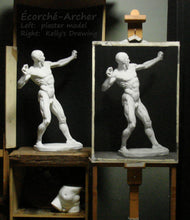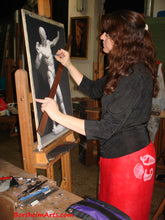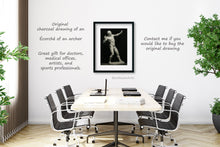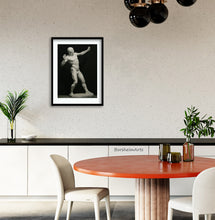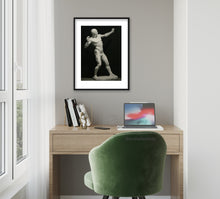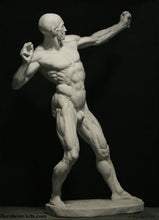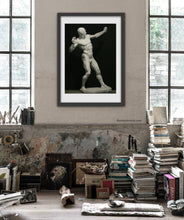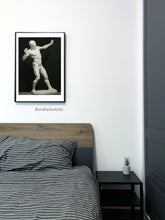
- Charcoal and black pastel on white Firenze-brand Italian Paper
- 64 x 46 cm (25 x 18 inches)
- Available, prints too, by special order
Écorché ~ The Archer
Charcoal Drawing by Kelly Borsheim,
The Making of the Original Charcoal Drawing "Écorché -- The Archer":
An Écorché is an artist's tool, basically a plaster human figure without the skin. It is used to study the musculature and anatomy of the human form. Artist Kelly Borsheim used the sight-size method to create the drawing shown on this page of an archer Écorché. This drawing was created on white Firenze-brand paper. There is no white added to this charcoal drawing; the lightest areas are the pure paper showing through.
Great wall art decor for professional offices, such as for medical staff, doctors, sports professionals, or artists. Anyone interested in human anatomy or even archery, will enjoy this black and white original drawing of charcoal on white paper.
In the sight-size method, the composition is set up and the easel is placed next to the object(s), usually aligned in the center or 2/3 of the center of the object. The easel is turned so that it faces exactly perpendicular to the artist's line of vision when in the viewing spot. The artist observes both subject and "canvas" from a specific viewing point (usually some distance away), then walks up to the drawing board to make her mark. Then she turns around and returns to the viewing point to determine if the mark was accurate. If not, she will approach the drawing and make a more correct mark, repeating as necessary. There is a lot of walking or pacing back and forth in the Sight-Size Method of Drawing. Healthy art ;-)

The precise drawing is figured out and done on scrap paper before transferring over to the real paper for the final drawing on white paper. That way the erased markings do not damage the paper of the final artwork.
In this case, the plaster sculpture of the archer is larger than the paper for the drawing. So, in order to use the sight-size method, the drawing board had to be placed forward enough in front of the model so that from the viewing distance (about two meters) the model and the drawing appear to be the same size. First the height is drawn, then the bottom is determined. Sides, and so on, until the outline of the figure has been drawn to match the model's shape and size.

After refining the line drawing, some tone is added to help the artist correct the shapes in the figure.
The charcoal drawing cannot possibly have the full range of tone as compared to what our eye can see in the original. However, some of the art tricks we use allow the viewers to not think about these things. In a similar way that a sculptor compresses the form to create a bas-relief sculpture, so the two-dimensional artist compresses the tone to match the possible range of the drawing materials used.
Note how controlled the lighting is. If a window in the room (or even, in some cases, the next room) is changed to alter the light in the room (opening a shutter for example), all is lost. In color painting, even wearing bright clothing or moving bright objects in the room will affect the light/color in the artwork! Also, even something as seemingly simple as the height of the artist's shoes must stay the same. Otherwise, one corrects the work from days before, only to feel incredibly frustrated to realize that all the changes are wrong, once the original pair of shoes is worn again in the studio.
Yes, it is quite an exacting process. However, this trains the hand, eye, brain communication triangle like no other exercise!
After removing the drawing from the setup, Kelly added some final touches before photographing her artwork.
Prints are available. Please message the studio in the link below to give desired size measurements.

![Detail of the charcoal and black pastel [to increase tonal range] drawing on Italian paper, showing the head and one hand of the Écorché, the archer. Note the subtlety and expert handling of the tone changes and anatomy model.](http://borsheimarts.com/cdn/shop/products/EtsyPR_ecorche25-DETAIL-charcoalpasteldrawing_{width}x.jpg?v=1646683991)








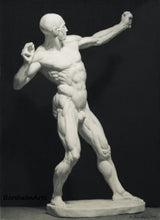
![Load image into Gallery viewer, Detail of the charcoal and black pastel [to increase tonal range] drawing on Italian paper, showing the head and one hand of the Écorché, the archer. Note the subtlety and expert handling of the tone changes and anatomy model.](http://borsheimarts.com/cdn/shop/products/EtsyPR_ecorche25-DETAIL-charcoalpasteldrawing_110x110@2x.jpg?v=1646683991)
